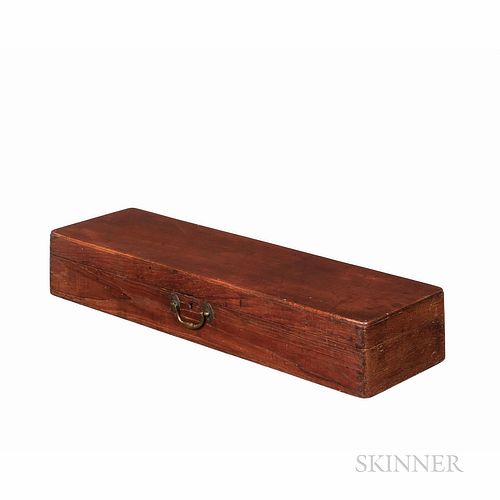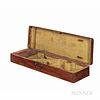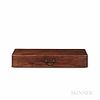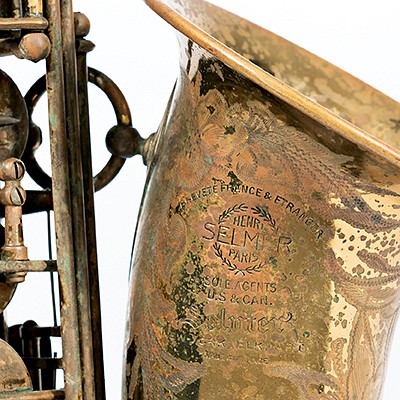English Georgian Teak Violin Case, c. 1850, the brass screws, approximate length of back 355 mm, ht. 4 7/8, wd. 30 1/2, dp. 9 in.Proven
Lot 1046
About Seller
Bonhams Skinner
274 Cedar Hill Street
Marlborough, MA 01752
United States
Founded over four decades ago, Bonhams Skinner offers more than 60 auctions annually. Bonhams Skinner auctions reach an international audience and showcase the unique, rare, and beautiful in dozens of categories, including the fine and decorative arts, jewelry, modern design, musical instruments, sc...Read more
Categories
About Auction
Catalog Only
By Bonhams Skinner
Nov 9, 2020 - Nov 19, 2020
Set Reminder
2020-11-09 12:00:00
2020-11-19 19:00:00
America/New_York
Bidsquare
Bidsquare : Fine Musical Instruments
https://www.bidsquare.com/auctions/skinner/fine-musical-instruments-5991
Our fall Fine Musical Instruments online auction is bookended by two notable collections – the violin case research collection of author Dr. Glenn P. Wood and the collection of jazz guitarist John Abercrombie. Bonhams Skinner bidsquare@bonhamsskinner.com
Our fall Fine Musical Instruments online auction is bookended by two notable collections – the violin case research collection of author Dr. Glenn P. Wood and the collection of jazz guitarist John Abercrombie. Bonhams Skinner bidsquare@bonhamsskinner.com
- Lot Description
English Georgian Teak Violin Case, c. 1850, the brass screws, approximate length of back 355 mm, ht. 4 7/8, wd. 30 1/2, dp. 9 in.
Provenance: The collection of Dr. Glenn P. Wood.
N.B. "This case is remarkable in many ways. Stylistically, we can place it in the late Georgian period, c. 1820-1850. That it is English is indicated by many detail features. Although there are a few small nails, small screws have mostly been used in its construction. Screws were well known in England at this date and earlier because the technology for producing them had been well developed for the manufacture of watches and clocks. In America, nails were mostly used.
A clue to the date comes from the impossibility of placing in it a violin with modern dimensions. Only those with a shorter, baroque neck will fit.
From the exterior it is possible to appreciate the fine dovetailing and precise placing of the box opening to accurately bisect a dovetail on each corner. Inside, it can be seen that the end plates and the separately cut valence strips were fashioned from thick blocks and trimmed down to leave thickness for the corners. This is an especially remarkable feature in the side parts of the valence (now mostly lacking the upper projections) which is only 2 mm thick.
One feature of the case construction overshadows all others when the case is opened - the strong aroma of teak wood. From the outside, the case appears to be made of mahogany and the top could indeed be of that wood but all the rest is teak - a wood virtually unknown in the Americas as it is a native of India and Southeast Asia. This curious fact is possibly explained when we relate that the case was discovered in an antique shop in Zebulon, North Carolina, east of Raleigh, but still a good drive from the coast. This area is littered with plantations belonging to wealthy owners who imported luxury goods from Europe.
It helps to know that teak (tectona grandis) is a tropical hardwood. It is resistant to termite attacks and damage caused by other insects. It is particularly valued for its durability and water resistance, and is used for boat building, exterior construction, veneer and furniture.
In addition to relatively high strength, teak is also highly resistant to rot, fungi and mildew. In addition, teak has a relatively low shrinkage ratio, which makes it excellent for applications where it undergoes periodic changes in moisture. It would therefore be a natural choice of wood for a commission to build a case to protect a valuable violin for shipment to the hot and humid Carolinas where it has remained free of cracks in the 250 years of its life.
Aesthetically, this case represents a perfect transition from the chests of the baroque to the high style of the Victorian cases epitomised by the art cases of W.E. Hill & Sons of the end of the 19th century."
G.P.W.
Any condition statement is given as a courtesy to a client, is only an opinion and should not be treated as a statement of fact. Skinner Inc. shall have no responsibility for any error or omission. The absence of a condition statement does not imply that the lot is in perfect condition or completely free from wear and tear, imperfections or the effects of aging. - Shipping Info
-
Please visit http://www.skinnerinc.com/services/payment-and-shipping/ for information regarding the collection of items purchased at auction.
-
- Buyer's Premium



 EUR
EUR CAD
CAD AUD
AUD GBP
GBP MXN
MXN HKD
HKD CNY
CNY MYR
MYR SEK
SEK SGD
SGD CHF
CHF THB
THB













